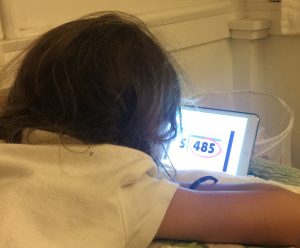
ICYMI in our last post, in a flipped classroom, students study the content at home online before coming to class to discuss/practice it.
Now that we’ve discussed what flipping is and how it’s different from blended learning, let’s talk about how you can actually flip your classroom. Below you’ll find some of our top tips on how to make the transition as smooth and easy as possible. We promise it’ll be a lot easier than traveling a thousand miles to retrace your ancestors’ steps like the kids do in our game Forgotten Trail (which you can get here)!
Start small
Flipping all of your classes at the same time may make you flip out. The same can be said for completely flipping a class all at once. How about working things in little by little? For example- rather than asking your students if they have any questions at the end of a lesson, have an online FAQ board for them. They can go there, post and answer each other’s questions. This not only gives you extra classroom time but it engages all students. You can also ask them a question and see how they interact in a chat and how they apply what they learned during class.
Which model makes sense for your classroom?
Each classroom is different and keeping that in mind when drafting your flip plan is imperative. The University of Texas at Austin’s Faculty Innovation Center recommends asking yourself the following questions:
What classes do you currently have an in-class activity that you rarely have time to complete during class and requires the students to apply their knowledge and skills?
What concepts or topics do students struggle the most to understand based on exam scores and/or assignment grades?
What topics would students benefit from the opportunity to apply the concepts within the classroom where your expertise could guide their development?

Make videos like this awesome one of AnnMaria discussing probability with her guinea pigs.
Make Online Videos
Rather than dictate a lesson to the class, dictate it to the camera. There are various resources available online for free that help you put together your lecture. Have fun with it knowing you’re not having to cut an explanation in half because of timing purposes. Since it’s video your students can still truly capture your teaching style and pace. But, don’t make the videos too long! They should be clear and concise. You should shoot for 5-10 minutes. Also, make sure to give them a schedule so they stick to a deadline!
Differentiated Learning
One big challenge for teachers is being able to meet the educational needs of every student. Not every student learns at the same pace, but flipping can help you create lessons that work for all students. In a flipped classroom struggling students can go home and rewatch the material as many times as they need to. You can also offer additional videos so students have the option of delving deeper into a topic if they feel the need to. The same goes for faster learners as well!
Involve the parents!
When your students’ parents went to school things were VERY different. It’s important to educate them and keep them informed about what’s going on in and out of the classroom. Talk to parents about the goals, rationale, and logistics of flipping. If parents aren’t involved at home the flipping model won’t work. Invite them to sit with their kid as she/he watches the lecture assigned. You can also offer them a guide before the school year begins, that way they are informed and can ask any questions on Day 1.
